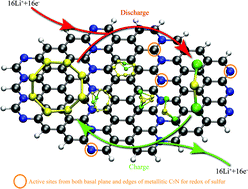Metallic C5N monolayer as an efficient catalyst for accelerating redox kinetics of sulfur in lithium–sulfur batteries†
Abstract
Lithium–sulfur battery is one of the most promising applicants for the next generation of energy storage devices whose commercial applications are impeded by the key issue of the shuttle effect. To overcome this obstacle, various two-dimensional (2D) carbon-based metal-free compounds have been proposed to serve as anchoring materials for immobilizing soluble lithium polysulfides (LiPs), which however suffer from low electronic conductivity implying unsatisfactory performance for catalyzing sulfur redox. Therefore, we have predicted metallic C5N monolayers, possessing hexagonal (H) and orthorhombic (O) phases, exhibiting excellent performance for suppressing the shuttle effect. First-principles simulations demonstrate that O-C5N could serve as a bifunctional anchoring material due to its strong adsorption capability to LiPs and excellent catalytic performance for sulfur redox with active sites from both basal plane and zigzag edges. Furthermore, the rate of Li2S oxidation over O-C5N is fast due to the low energy barrier of 0.93 eV for Li2S decomposition. While for H-C5N, only N atoms located at the armchair edges can efficiently trap LiPs and boost the formation and dissociation of Li2S during discharge and charge processes, respectively. The current work opens an avenue of designing 2D metallic carbon-based anchoring materials for lithium–sulfur batteries, which deserves further experimental research efforts.



 Please wait while we load your content...
Please wait while we load your content...